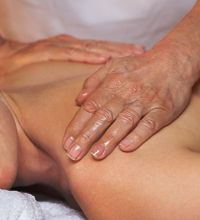Healing Hands: Massage Therapy Can Offer Relief for CIPN Symptoms
Massage therapy may offer relief to patients suffering from chemotherapy-induced peripheral neuropathy (CIPN).
Massage Therapy Can Offer Relief for CIPN Symptoms

Chemotherapy-induced peripheral neuropathy (CIPN) is one of the most common reasons patients with cancer stop treatment early, according to the National Cancer Institute. However, massage therapy (MT) may be a way to ease symptoms and improve quality of life, researchers reported at the 2016 Palliative Care in Oncology Symposium.1
The study, by a team of researchers from Boston University School of Medicine and Roger Williams Medical Center in Providence, Rhode Island, tested MT as a primary and secondary preventive treatment of CIPN symptoms.
Sixty-two patients participated in this single-arm, 10-week study that included a pre- and post-intervention survey assessment adapted from a prior study of novel approaches to CIPN in patients with multiple myeloma.2 Of the total, 97% had at least 2 CIPN-related symptoms prior to their first session. After the first MT session, at least 50% of patients reported improvements in all CIPN-related symptom categories. Up until at least the second session of MT, all patients maintained symptom improvement, except for those with from auditory-related symptoms.
The most common CIPN symptom experienced by patients was numbness or tingling in the feet (52%), and after the first session of massage therapy, 72% saw an improvement. Additionally, 47% reported that the improvement lasted until the second session.
The symptom which received the highest average improvement was the feeling of overall weakness, with an average 67.5% improvement after the first session. The highest sustained average improvement from the first to the second session was in difficulty walking, which improved by 45% and 50%, respectively.
Researchers also noted that patients using painkillers may benefit from MT. Twenty-five patients in the study cohort were taking pain medication, of whom 56% experienced no symptom progression after the first MT session, and of the 13 patients who attended the second MT session, 38% reported no progression, and 31% reported a complete resolution of symptoms. The remaining 31% did have a progression of symptoms.
Overall, CIPN symptoms improved an average of 45%, with the exception of vestibulocochlear symptoms, such as difficulty hearing and buzzing or ringing in the ears.
Study authors wrote that they hoped their findings would promote the use of MT as, “an effective prophylactic and therapeutic option,” and that the data suggest a benefit for the subset of patients who are taking analgesics.
The researchers also noted that, “a median of 97% of patients who did not complain of CIPN-related symptoms never develop the symptom. Although no control group was present, we hypothesize that massage therapy might also be a viable preventive modality for CIPN,” and they called for further studies focused on approaches to treat auditory symptoms related to CIPN.
Reference
1. Menendez AG, Cobb R, Carvajal AR, et al. Effectiveness of massage therapy (MT) as a treatment strategy and preventive modality for chemotherapy-induced peripheral neuropathy (CIPN) symptoms. J Clin Oncol. 2016;34(suppl 26S; abstr 193)
2. Tairiman JD, Love G, McCullagh E, et al. Peripheral neuropathy associated with novel therapies in patients with multiple myeloma: consensus statement of the IMF Nurse Leadership Board. Clin J Oncol Nurs. 2008;12(3 suppl):29-36.


